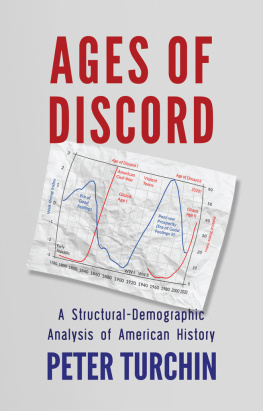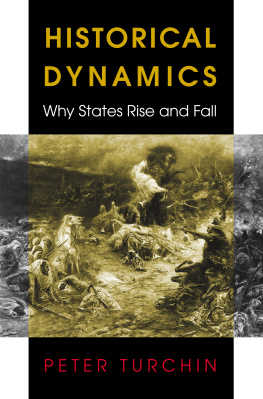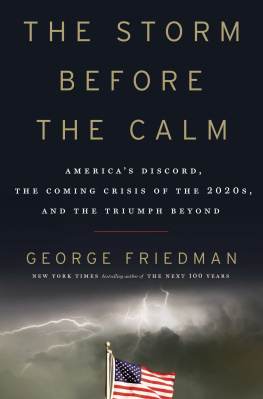Peter Turchin - Ages of Discord
Here you can read online Peter Turchin - Ages of Discord full text of the book (entire story) in english for free. Download pdf and epub, get meaning, cover and reviews about this ebook. year: 2016, publisher: =, genre: Science. Description of the work, (preface) as well as reviews are available. Best literature library LitArk.com created for fans of good reading and offers a wide selection of genres:
Romance novel
Science fiction
Adventure
Detective
Science
History
Home and family
Prose
Art
Politics
Computer
Non-fiction
Religion
Business
Children
Humor
Choose a favorite category and find really read worthwhile books. Enjoy immersion in the world of imagination, feel the emotions of the characters or learn something new for yourself, make an fascinating discovery.
- Book:Ages of Discord
- Author:
- Publisher:=
- Genre:
- Year:2016
- Rating:5 / 5
- Favourites:Add to favourites
- Your mark:
- 100
- 1
- 2
- 3
- 4
- 5
Ages of Discord: summary, description and annotation
We offer to read an annotation, description, summary or preface (depends on what the author of the book "Ages of Discord" wrote himself). If you haven't found the necessary information about the book — write in the comments, we will try to find it.
Ages of Discord — read online for free the complete book (whole text) full work
Below is the text of the book, divided by pages. System saving the place of the last page read, allows you to conveniently read the book "Ages of Discord" online for free, without having to search again every time where you left off. Put a bookmark, and you can go to the page where you finished reading at any time.
Font size:
Interval:
Bookmark:
Ages of Discord
A STRUCTURAL-DEMOGRAPHIC ANALYSIS
OF AMERICAN HISTORY
Peter Turchin

Beresta Books
Beresta Books
Published by BERESTA BOOKS LLC
Chaplin, Connecticut, U.S.A.
AGES OF DISCORD:
A STRUCTURAL-DEMOGRAPHIC ANALYSIS OF AMERICAN HISTORY
Copyright 2016 by Peter Turchin
All rights reserved. This book may not be reproduced in whole or in part without permission from the publisher.
Library of Congress Cataloging-in-Publication Data
Turchin, Peter, 1957
Ages of Discord: A Structural-Demographic Analysis of American History / Peter Turchin
p. cm.
Includes bibliographical references and index
1. History United States. 2. Social Dynamics Mathematical Models.
3. Power Elites Cooperation. 4. Political Violence Social aspects.
5. Inequality Effects on Social Structures. I. Title
Preface
Is America headed in the wrong direction? An increasing proportion of Americans are saying yes. For what its worth, the subjective mood of gloom (and even doom) is buttressed by a variety of data trendstoo many for comfort.
Inequality of both income and wealth has been increasing in the US since the 1970s. As a result, there are many more wealthy Americansthe number of multimillionaires quadrupled between 1983 and 2007. At the same time, the real (inflation-adjusted) wage of American men today is lower than 40 years ago. Today, median-wage earners have to work twice as many months to earn the price of a median home, compared with 30 years ago. Between 1999 and 2015, the suicide rate rose by 24 percent. Things are so bad that the life expectancy of middle-aged, white Americans is declininga shocking statistic in a modern postindustrial country not at war.
Signs of government dysfunction and gridlock abound. The effects of rampant political polarization among the political class are particularly visible in the Senate, which has been inundated by a wave of filibusters. Whereas during the 1960s nearly all judges nominated for US District Courts were confirmed by the Senate, today half of the nominations are rejected. In 2016 the intransigent Senate refused to consider the Presidents nominations for the Supreme Court, so currently (as of summer of 2016) we have only eight supreme justices.
The American infrastructure is fraying, the politics are becoming more poisonous, and the trust in government has plummeted. On top of this, there is an epidemic of domestic terrorism, although it is not often acknowledged as such by the media or political elites. Every year, greater numbers of Americans, armed with guns, go on shooting rampages killing strangers and passers-by. The incidence of such indiscriminate mass murder has increased twentyfold over the past 40 years, and nobody can explain why. No wonder that, according to the latest NBC/Wall Street Journal poll, 70 percent of Americans think that things are off on the wrong track.
Troubling trends of this kind are constantly discussed by politicians, public intellectuals, and social scientists. But most commentators see only a small slice of the overall problem. Indeed, what do increasingly frequent shooting rampages have to do with the polarization in Congress? Or falling life expectancies for large segments of the American population? Is there a connection between too many multimillionaires and more filibusters in the Senate?
In this book I will argue that the trends listed above, and many others, are indeed interrelated. Analysis by my colleagues and me of historical states shows that complex, large-scale human societies tend to go through cycles of alternating integrative and disintegrative phases. Long periods of relative equity, prosperity, and internal peace are succeeded by periods of inequity, immiseration, and political instability, frequently ending in state collapses, revolutions, and civil wars. Each of the secular phases, integrative and disintegrative, unfolds over several human generations. The typical period of the overall secular cycle is around two centuries, although there is a lot of variability, depending on the type of society in question, starting conditions, and chance events.
What is particularly relevant to the questions with which I started this Preface, is that while post-crisis dynamics can take many routes, the pre-crisis periods tend to have the same characteristic features, shared across many societies and even different historical eras. The American polity today has a lot in common with the Antebellum America of the 1850s; with Ancien Rgime France on the eve of the French Revolution; with Stuart England during the 1630s; and innumerable other historical societies that went through integrative/disintegrative cycles. Can it really be true that the troubles of our days are not so new, and many historical societies experienced them previously? I will marshal empirically supported theory and a lot of data to show that this is, indeed, the case.
However, unlike historical societies, we are in a unique position to take steps that could allow us to escape the worst. Societal breakdown and ensuing waves of violence can be avoided by collective, cooperative action. My goal is to present in this book the best current understanding of why political violence in states waxes and wanes in long cycles. This understanding is encapsulated in what has become known as Structural-Demographic Theory (SDT), whose empirical adequacy has been tested on a number of historical societies. As we shall see in this book, the SDT helps us answer why the various trends mentioned earlier changed direction from favorable to unfavorable in America around the 1970s. Such understanding is the key to developing reforms that would reverse these negative trends, and move us to a more equitable, prosperous, and peaceful society.
All data trends mentioned in the Preface will be discussed and referenced in the main body of the book.
Acknowledgments
I would like to thank Radek Szulga, Ross Hartshorn, and Jim Bennett, who read and commented on a complete draft of the manuscript. Over the years, I have profited from many discussions with my colleagues. Here is an incomplete list (please forgive me if I have left you out): Mark Ames, Paul Gilje, Herb Gintis; Jim Bennett, Kevin Feeney, and the rest of the Seshat crew; Andrey Korotayev, Sergey Nefedov, and other members of the Russian Cliodynamics community; and my colleagues in the Evolution Institute: David Sloan Wilson, Jerry Miller, Joe Brewer, and Robert Kadar. Id like also to thank Alexander Dibrov, MD, for drawing my attention to data on the overproduction of medical degrees ().
Many years ago, when I was not yet sure that I should pursue this project, Jack Goldstone, the father of the Structural-Demographic Theory, gave me the encouragement I needed to start me on this long road. As I wrote, I revisited his magisterial Revolution and Rebellion in the Early Modern World many, many times, and never failed to be impressed by the prescience of his book in respect of subsequent developments in structural theories of revolution and internal war.
During the preparation of this volume for publication, I have been ably helped by a talented team: Agathe Dupeyron, who chased down many hard-to-find facts and bits of data; Simon Reynolds, whose editing skills made the manuscript immeasurably more readable; Greg Laszczyk, who typeset it; and Marta Dec, who designed the cover.
As always, my greatest debt of gratitude is to my wife Olga, whose support and encouragement sustained me during the long (but, thanks to her, never lonely) years of working on the book.
Next pageFont size:
Interval:
Bookmark:
Similar books «Ages of Discord»
Look at similar books to Ages of Discord. We have selected literature similar in name and meaning in the hope of providing readers with more options to find new, interesting, not yet read works.
Discussion, reviews of the book Ages of Discord and just readers' own opinions. Leave your comments, write what you think about the work, its meaning or the main characters. Specify what exactly you liked and what you didn't like, and why you think so.










